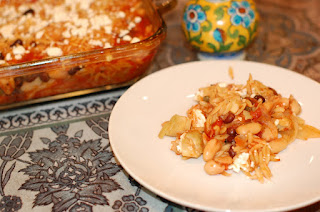
In my attempt to buy on sale, I decided to use this Pasta with Squash, Brown Butter and Rosemary recipe from Rachael Ray since butternut squash was 39 cents a pound at Whole Foods last week. I looked at two different supermarkets for fresh rosemary and didn't find any at either, which is funny as I hardly ever use fresh herbs. So suffice it to say, you can use dried rosemary as a substitute when making this.
Pasta with Squash, Brown Butter and Rosemary
One 3-lb butternut squash--peeled, seeded and cut into 1/2-inch cubes
1 onion, chopped
2 1/2 tbsp extra-virgin olive oil
1 1/2 tbsp chopped fresh rosemary (approx. 2 tsp dried)
salt and pepper
2/3 lb lasagna noodles, broken into pieces
4 tbsp butter
1 tsp fresh lemon juice
1/2 cup grated parmesan cheese
3 tbsp toasted pine nuts (optional)
1. Preheat the oven to 400 degrees. In a large bowl, toss the squash, onion, olive oil and rosemary; season with salt and pepper. Place on a baking sheet and roast until the squash is tender, about 30 minutes.
2. Meanwhile, in a large pot of boiling, salted water, cook the pasta until al dente; drain and transfer to a large bowl.
3. In a small skillet, melt the butter over medium heat and cook, stirring occasionally, until golden, about 7 minutes. Stir in the lemon juice.
4. Add the roasted squash, brown butter and 1/3 cup parmesan to the pasta and toss; season with salt and pepper. Top with the pine nuts and remaining parmesan.
The Verdict: My husband and son both liked it because they were oblivious to my faux pas. As the cook, I'd probably like it better if it weren't Pasta with Squash, Black Butter and Rosemary.
Yes, I burned the butter. I made this dish earlier in the day so that I could bring my toddler out for the afternoon. Of course, to foil my plan, he decided it was a no-nap day. So whilst trying to entertain him, cook, and write an email on my Blackberry, something had to give. And it was the butter, which quickly went from a lovely, rich brown to a witch's brew that spat angrily when I added the lemon. So there's a heads up--keep a closer eye than I did on your butter!
Luckily, the butter looked like it was flecked with pepper and didn't taste charred.
The roasted butternut squash was absolutely delicious, and surprisingly, my kiddo ate it as well. His father billed it as "pumpkin" which seemed to pique his interest. Not sure why, but it did.
I found the 2/3 of a pound of pasta ingredient to be a bit tedious--what exactly is 2/3 of a pound of pasta? Before sweating it too much, I decided I didn't care. I had two boxes of leftover lasagna noodles and quite a few large pasta shells. Worked for us. Here's a kitchen tip--if you have a recipe asking for large broken noodles, put them in a freezer bag and gently hammer them with a meat mallet. Took me a while to figure this out personally. Instead, I dealt with shards of razor-like pasta flying through the kitchen and precariously close to my eyes many times before this "a-ha" moment.
This dish is simple, easy (overlooking the butter), and feels like fall. It's a great, filling vegetarian dish.


















